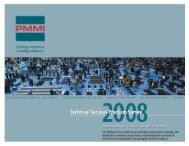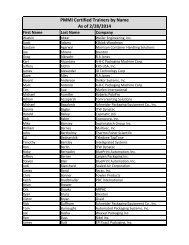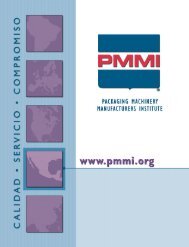Canadian Packaging Machinery Market Research Report - PMMI
Canadian Packaging Machinery Market Research Report - PMMI
Canadian Packaging Machinery Market Research Report - PMMI
Create successful ePaper yourself
Turn your PDF publications into a flip-book with our unique Google optimized e-Paper software.
In 2002, Quebec accounted for 21 per cent of Canada’s GDP, 23.5 per cent of<br />
Canada’s total manufacturing shipments, and 24 per cent of Canada’s population.<br />
One of the main differences between Canada and the U.S. is that, under the Official<br />
Languages Act, Canada is officially a bilingual country. 22.6 per cent of <strong>Canadian</strong>s<br />
consider French as their native language, and of this, 80.2 per cent live in the<br />
province of Quebec. However, whether a person is English or French speaking,<br />
residing in the West Coast, Central or Atlantic region, all <strong>Canadian</strong>s have the right to<br />
receive federal government services in English or French.<br />
1.2 GEOGRAPHY AND POPULATION<br />
Canada is the second largest country by land area in the world. Its borders<br />
encompass a total land mass of approximately 9.984 million square kilometers. It is<br />
smaller than the Russian Federation, but larger than both China and the United<br />
States of America. It occupies roughly two-fifths of the North American continent.<br />
Canada’s population was estimated to be 31.5 million on January 1, 2003, and<br />
between 2002 and 2003, Canada’s population grew by 0.8 per cent. In comparison,<br />
Census Bureau inter-census projections indicate that the U.S. population grew by 1.2<br />
per cent between July 1 2002 and July 1 2003.<br />
Canada is a highly urbanized nation as 79.7 per cent of the population live in urban<br />
areas. Approximately 90 per cent of the <strong>Canadian</strong> population live within 100 miles of<br />
the Canada/U.S. border. 62.2 per cent of the <strong>Canadian</strong> population are concentrated<br />
in the provinces of Ontario and Quebec. The population of Canada’s ten provinces,<br />
three territories, and the largest provincial and territorial cities, are set out in the<br />
following table.<br />
Table 1.1: Population of Canada’s Provinces, Territories, and Cities<br />
Province/Territory Population<br />
(January<br />
2003)<br />
Newfoundland and<br />
Labrador<br />
Largest City Population<br />
(Census<br />
2001)<br />
531,145 St. John's 172,918<br />
Prince Edward Island 140,412 Charlottetown 58,358<br />
Nova Scotia 944,456 Halifax 359,183<br />
New Brunswick 756,368 Saint John 122,678<br />
Quebec 7,467,626 Montreal 3,426,350<br />
Ontario 12,109,514 Toronto 4,682,897<br />
Manitoba 1,150,564 Winnipeg 671,274<br />
Saskatchewan 1,009,225 Saskatoon 225,927<br />
Alberta 3,134,286 Calgary 951,395<br />
British Columbia 4,155,779 Vancouver 1,986,965<br />
Yukon Territory 29,841 Whitehorse 21,405<br />
Northwest Territories 41,389 Yellowknife 16,541<br />
SMG/Columbia Consulting Group Page 4
















